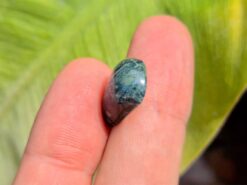Nepheline

Nepheline, also called nephelite is a feldspathoid: a silica-undersaturated aluminosilicate, Na3KAl4Si4O16, that occurs in intrusive and volcanic rocks with low silica, and in their associated pegmatites.
Buy natural gemstones in our shop
The crystals are rare and belong to the hexagonal system, usually having the form of a short, six-sided prism terminated by the basal plane. The unsymmetrical etched figures produced artificially on the prism faces indicate, however, that the crystals are hemimorphic and tetartohedral, the only element of symmetry being a polar hexad axis.
It is found in compact, granular aggregates, and can be white, yellow, gray, green, or even reddish, in the eleolite variety. The hardness is 5.5 – 6, and the specific gravity 2.56 – 2.66. It is often translucent with a greasy luster.
The low index of refraction and the feeble double refraction in the stone are nearly the same as in quartz, but since in the stone the sign of the double refraction is negative, while in quartz it is positive, the two minerals are readily distinguished under the microscope.
An important determinative character of the stone is the ease with which it is decomposed by hydrochloric acid, with separation of gelatinous silica, which may be readily stained by coloring matters, and cubes of salt. For this reason, a clear crystal becomes cloudy when immersed in acid.
Although sodium and potassium are always present in naturally occurring stone in approximately the atomic ratio 3:1, artificially prepared crystals have the composition NaAlSiO4, the corresponding potassium compound, KAISiO4, which is the mineral kaliophilite, has also been prepared artificially.
It has therefore been suggested that the orthosilicate formula, (Na,K)AlSiO4, represents the true composition of the stone.
The mineral is one especially liable to alteration, and in the laboratory various substitution products of the stone have been prepared. In nature it is frequently altered to zeolites, especially natrolite, sodalite, kaolin, or compact muscovite. Gieseckite and liebenerite are pseudomorphs.
Two varieties of nepheline are distinguished
Differing in their external appearance and in their mode of occurrence, being analogous in these respects to sanidine and common orthoclase respectively. Glassy nepheline has the form of small, colorless, transparent crystals and grains with a vitreous luster.
It is characteristic of the later volcanic rocks rich in alkalis, such as phonolite, nepheline-basalt, leucite basalt, etc., and also of certain dike-rocks, such as tinguaite. The best crystals occur with mica, sanidine, garnet, etc., in the crystal-lined cavities of the ejected blocks of Monte Somma, Vesuvius.
The other variety, known as elaeolite, occurs as large, rough crystals, or more often as irregular masses, which have a greasy luster and are opaque, or at most translucent, with a reddish, greenish, brownish or grey color.
It forms an essential constituent of certain alkaline plutonic rocks of the nepheline syenite series, which are typically developed in southern Norway.
Sample from Myanmar
FAQ
How can you tell nepheline from quartz?
The gemstone is softer than quartz and differs in optic sign. It occurs in alkali-rich, silicon poor igneous rocks (nepeline syenite, foidite and phonolite). May be found in some contact metamorphosed rocks.
Is nepheline a plagioclase?
The stone, a feldspathoid, is a common mineral in silica-undersaturated igneous rocks, such as plutonic nepheline syenites and volcanic phonolites. It is colourless in plane light with relief similar to K-feldspar, sodic plagioclase and other feldspathoids, with which it commonly occurs.
What is nepheline crystal healing uses?
Since ancient times, there are cultural beliefs that crystals are believed to heal afflictions in human beings. The stone has been used to calm children, banish nightmares, treat sleeping difficulties and stop temper tantrums. It can help in the treatment of stress and stress related disorders.
















